Geometry Defeaturing Effects in CFD Model-Based Assessment of an Open-Channel-Type UV Wastewater Disinfection System
Abstract
:1. Introduction
2. Materials and Methods
2.1. Model
2.2. Bioassay Test
2.3. Numerical Techniques
2.4. UV Radiation Model and Inactivation Kinetics
2.5. Boundary Conditions
3. Results and Discussion
3.1. Collimated Beam Result
3.2. Validation of CFD Methods
3.3. Effects of Geometry Defeaturing
3.4. Effects of Bank Additions
4. Conclusions
- In CFD modeling, a simple geometry (only lamp and channel) configuration can be used to evaluate the disinfection performance of the full scale UV system, under the assumption that the inlet flow conditions are relatively uniform.
- For both site-specific operation or CFD modeling, if the inlet flow conditions are not severely distorted, flow mixing would not be necessary to ensure proper disinfection performance.
- In multiple bank operation, the addition of banks yields a linear increment in the RED of the CFD model, but the actual measured doses can be higher. Thus, the delivered UV doses predicted by the CFD model might be underestimated, especially for serial bank addition.
- One reason that may contribute to the discrepancy between the CFD model and measured doses is that mixing of the water by secondary current or oscillation characteristics in open-channel flow cannot be properly captured in steady-state simulation.
Supplementary Materials
Acknowledgments
Author Contributions
Conflicts of Interest
References
- Oppenheimer, J.A.; Jacangelo, J.G.; Laine, J.-G.; Hoagland, J.E. Testing the equivalency of ultraviolet light and chlorine for disinfection of wastewater to reclamation standards. Water Environ. Res. 1997, 69, 14–24. [Google Scholar] [CrossRef]
- Cabaj, A.; Sommer, R. Measurement of ultraviolet radiation with biological dosimeters. Radiat. Prot. Dosim. 2000, 91, 139–142. [Google Scholar] [CrossRef]
- Bohrerova, Z.; Bohrer, G.; Mohanraj, S.; Ducoste, J.; Linden, K. Experimental measurements of fluence distribution in a UV reactor. Environ. Sci. Technol. 2005, 39, 8925–8930. [Google Scholar] [CrossRef] [PubMed]
- Blatchley, E., III; Shen, C.; Naunovic, Z.; Lin, L.; Lyn, D.; Robinson, J.; Ragheb, K.; Grégori, G.; Bergstrom, D.; Fang, S.; et al. Dyed Microspheres for Quantification of UV Dose Distributions: Photochemical Reactor Characterization by Lagrangian Actinometry. J. Environ. Eng. 2006, 132, 1390–1403. [Google Scholar] [CrossRef]
- Elyasi, S.; Taghipour, F. Performance evaluation of UV reactor using optical diagnostic techniques. AIChE J. 2011, 57, 208–217. [Google Scholar] [CrossRef]
- Gandhi, V.N.; Roberts, P.J.W.; Kim, J.H. Visualizing and quantifying dose distribution in a UV reactor using three-dimensional laser-induced fluorescence. Environ. Sci. Technol. 2012, 46, 13220–13226. [Google Scholar] [CrossRef] [PubMed]
- U.S. Environmental Protection Agency (EPA). Design Manual: Municipal Wastewater Disinfection; EPA Office of Research and Development: Washington, DC, USA, 1986.
- Lawryshyn, Y.; Hofmann, R. Theoretical Evaluation of UV Reactors in Series. J. Environ. Eng. 2015, 141, 04015023. [Google Scholar] [CrossRef]
- Zhang, J.; Tejada-Martínez, A.E.; Zhang, Q. Developments in computational fluid dynamics-based modeling for disinfection technologies over the last two decades: A review. Environ. Model. Softw. 2014, 58, 71–85. [Google Scholar] [CrossRef]
- Downey, D.; Giles, D.K.; Delwiche, M.J. Finite element analysis of particle and liquid flow through an ultraviolet reactor. Comput. Electron. Agric. 1998, 21, 81–105. [Google Scholar] [CrossRef]
- Lyn, D.; Chiu, K.; Blatchley, E.R., III. Numerical modeling of flow and disinfection in UV disinfection channels. J. Environ. Eng. 1999, 25, 17–26. [Google Scholar] [CrossRef]
- Liu, D.; Ducoste, J.J.; Jin, S.; Linden, K. Evaluation of alternative fluence rate distribution models. Aqua. J. Water Supply Res. Technol. 2004, 53, 391–408. [Google Scholar]
- Ducoste, J.; Liu, D.; Linden, K. Alternative Approaches to Modeling Fluence Distribution and Microbial Inactivation in Ultraviolet Reactors: Lagrangian versus Eulerian. J. Environ. Eng. 2005, 131, 1393–1403. [Google Scholar] [CrossRef]
- Munoz, A.; Craik, C.; Kresta, S. Computational fluid dynamics for predicting performance of ultraviolet disinfection—Sensitivity to particle tracking inputs. J. Environ. Eng. Sci. 2007, 6, 285–301. [Google Scholar] [CrossRef]
- Wols, B.A.; Hofman, J.A.M.H.; Beerendonk, E.F.; Uijttewaal, W.S.J.; van Dijk, J.C. A systematic approach for the design of UV reactors using computational fluid dynamics. AIChE J. 2011, 57, 193–207. [Google Scholar] [CrossRef]
- Saha, R.; Zhang, C.; Ray, M. Similitude in an Open-Channel UV Wastewater Disinfection Reactor. J. Environ. Eng. 2015, 141, 04014065. [Google Scholar] [CrossRef]
- Saha, R.K. Numerical Simulation of an Open Channel Ultraviolet Wastewater Disinfection Reactor. Master’s Thesis, The Univesity of Western Ontario, London, ON, Canada, 2003. [Google Scholar]
- National Water Research Institute (NWRI); American Waste Water Association Research Foundation (AWWARF). Ultraviolet Disinfection Guidelines for Drinking Water and Water Reuse, 3rd ed.; NWRI: Fountain Valley, CA, USA, 2012. [Google Scholar]
- Menter, F.R. Two-equation eddy-viscosity turbulence models for engineering applications. AIAA J. 1994, 32, 1598–1605. [Google Scholar] [CrossRef]
- Zwart, P.J. Numerical modeling of free surface and cavitating flows. In Proceedings of the Industrial Two-Phase Flow VKI Lecture Series, Brussels, Belgium, 23–27 May 2005. [Google Scholar]
- ANSYS. ANSYS CFX-Solver Theory Guide; ANSYS Inc.: Canonsburg, PA, USA, 2012. [Google Scholar]
- Schneider, G.E.; Raw, M.J. A skewed, positive influence coefficient upwinding procedure for control-volume-based finite-element convection-diffusion computation. Numer. Heat Transf. 1986, 9, 1–26. [Google Scholar] [CrossRef]
- Barth, T.J.; Jesperson, D.C. The design and application of upwind schemes on unstructured meshes. In Proceedings of the 27th Aerospace Sciences Meeting, Reno, NV, USA, 9–12 January 1989. [Google Scholar]
- Liu, D. Numerical Simulation of UV Disinfection Reactors: Impact of Fluence Rate Distribution and Turbulence Modeling. Ph.D. Thesis, North Carolina State University, Raleigh, NC, USA, 30 December 2004. [Google Scholar]
- Ho, C.K. Radiation dose modeling in Fluent. In Proceedings of the WEF Disinfection 2009 Workshop: Modeling UV Disinfection using CFD, Sandia National Laboratories, Albuquerque, NM, USA, 28 February 2009. [Google Scholar]
- Wols, B.A.; Hofman-Caris, C.H.M.; Harmsen, D.J.; Beerendonk, E.F.; van Dijk, J.C.; Chan, P.S.; Blatchley, E.R., III. Comparison of CFD, biodosimetry and Lagrangian actinometry to assess UV reactor performance. Ozone Sci. Eng. 2012, 34, 81–91. [Google Scholar] [CrossRef]
- Menter, F.R.; Ferreira, J.C.; Esch, T.; Konno, B. The SST Turbulence Model with Improved Wall Treatment for Heat Transfer Predictions in Gas Turbines. In Proceedings of the International Gas Turbine Congress, Tokyo, Japan, 2–7 November 2003. [Google Scholar]
- Pirnie, M.; Linden, K.G.; Malley, J.P.J. Ultraviolet Disinfection Guidance Manual for the Final Long Term 2 Enhanced Surface Water Treatment Rule; EPA office of Water: Washington, DC, USA, 2006.
- Younis, B.A.; Yang, T.H. Computational modeling of ultraviolet disinfection. Water Sci. Technol. 2010, 62, 1872–1880. [Google Scholar] [CrossRef] [PubMed]
- Younis, B.A.; Yang, T.H. Prediction of the effects of vortex shedding on UV disinfection efficiency. J. Water Supply Res. Technol. 2011, 60, 147–158. [Google Scholar] [CrossRef]
- Nezu, I. Open-channel flow turbulence and its research prospect in the 21st century. J. Hydraul. Eng. 2005, 131, 229–246. [Google Scholar] [CrossRef]
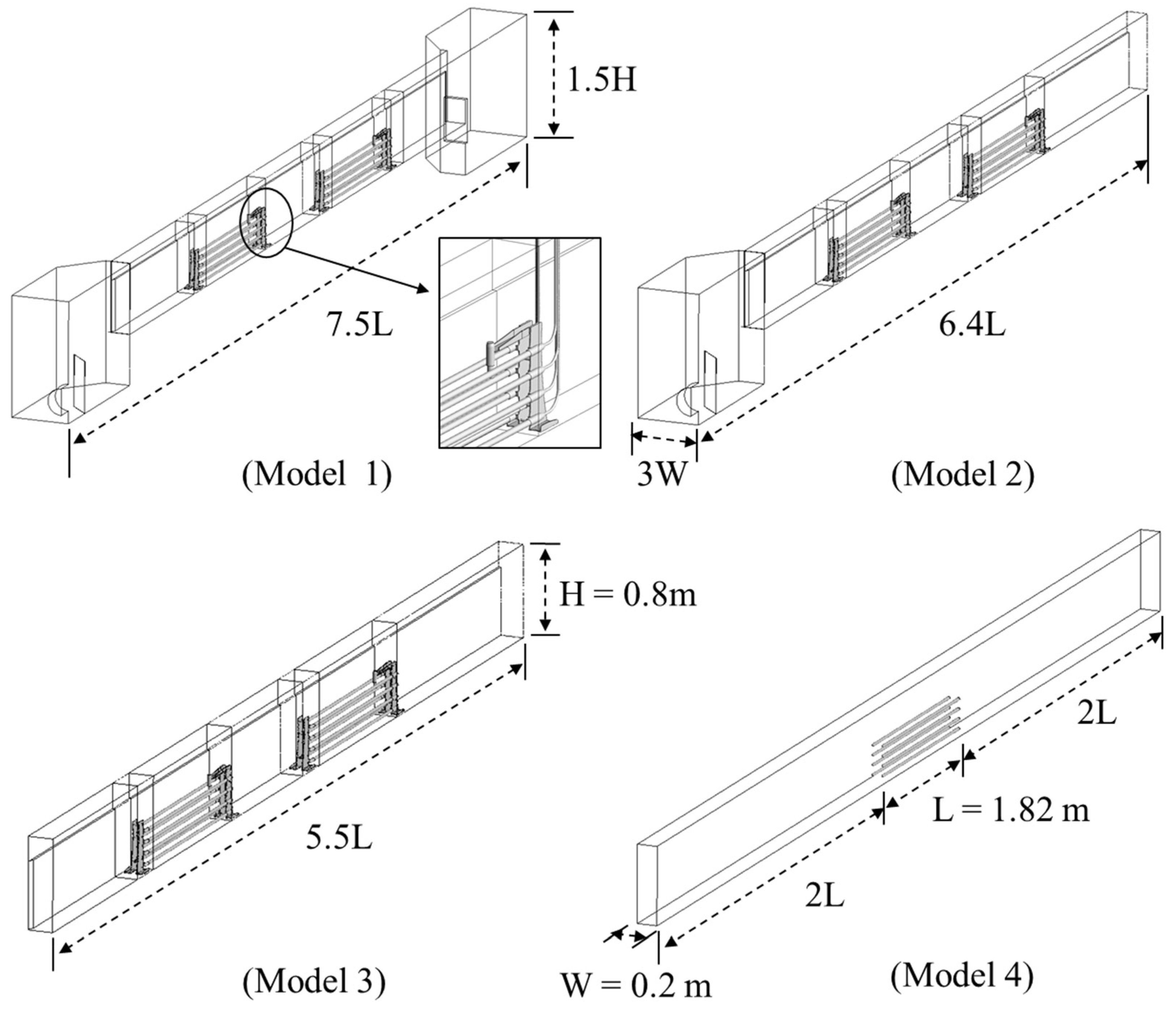
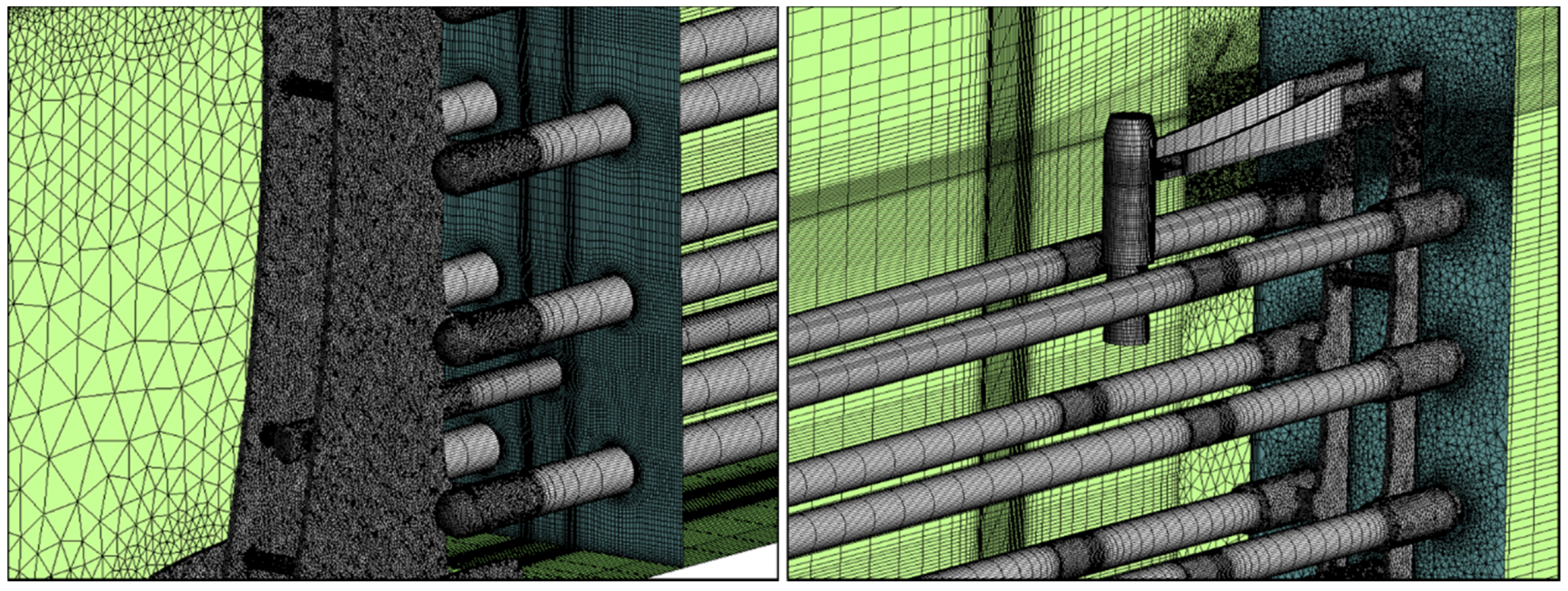

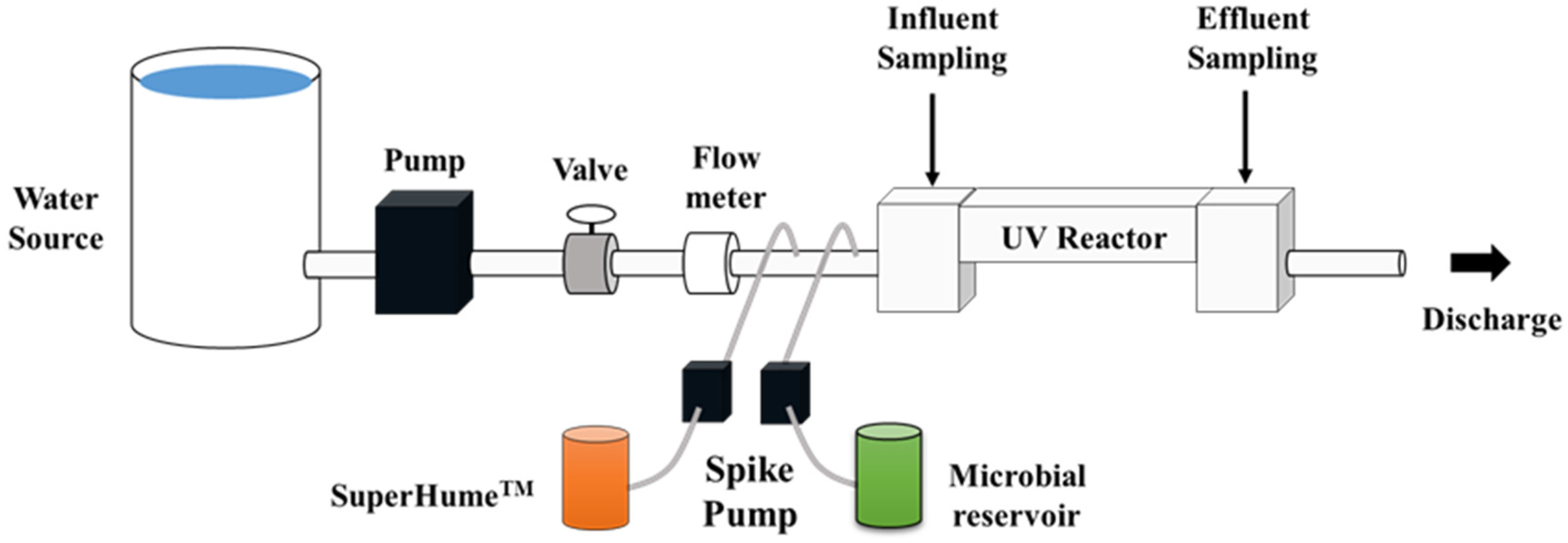


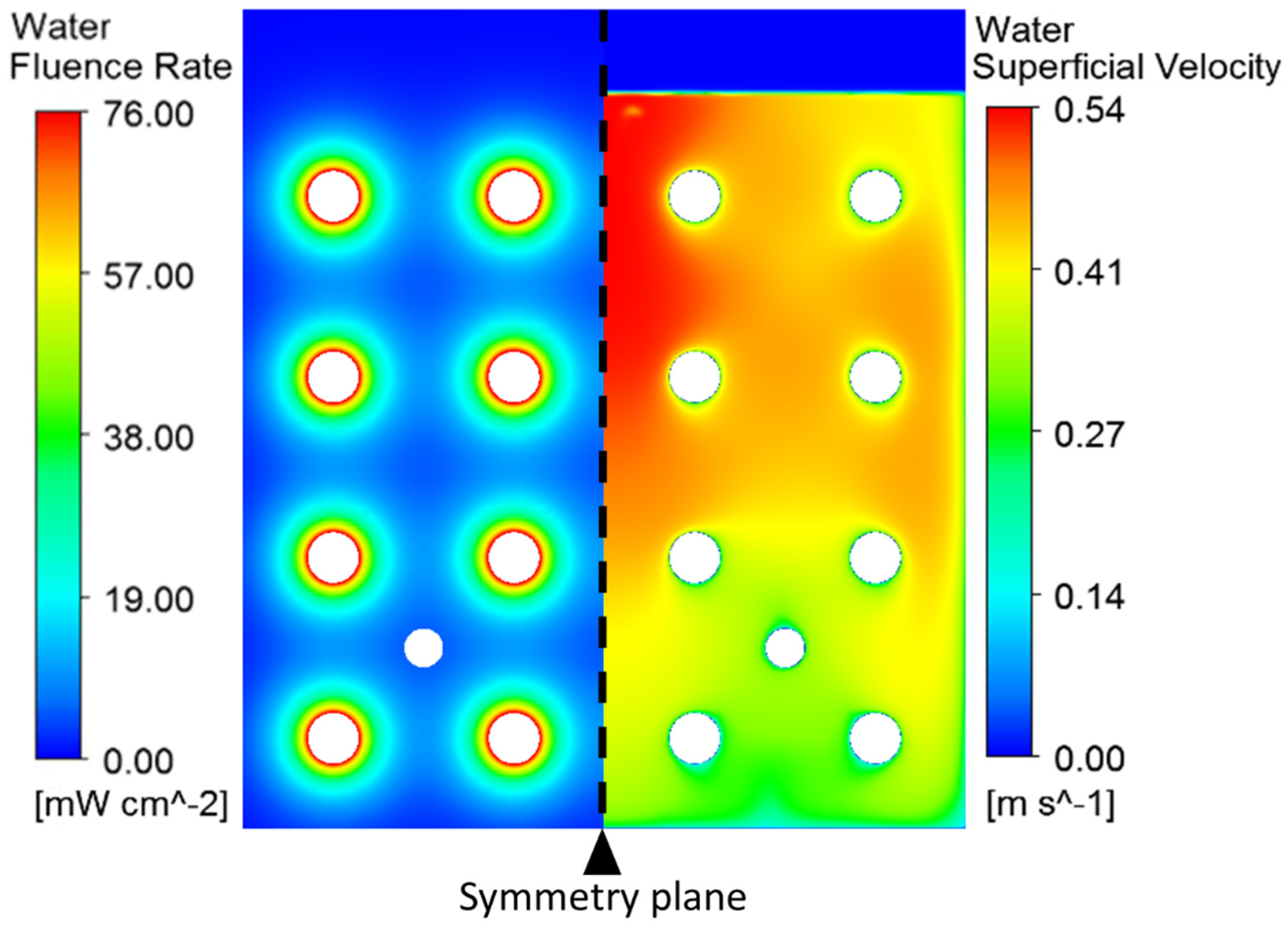
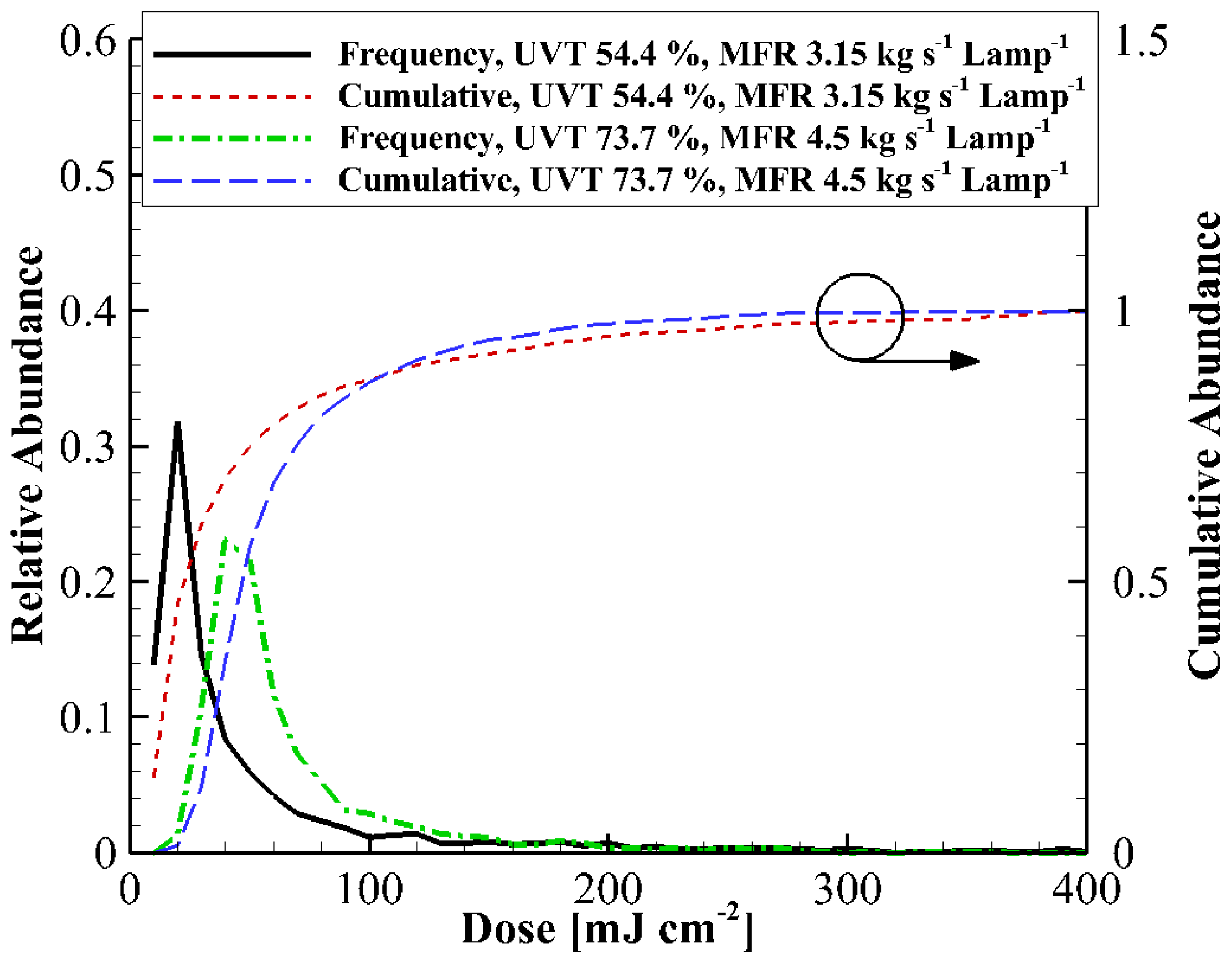
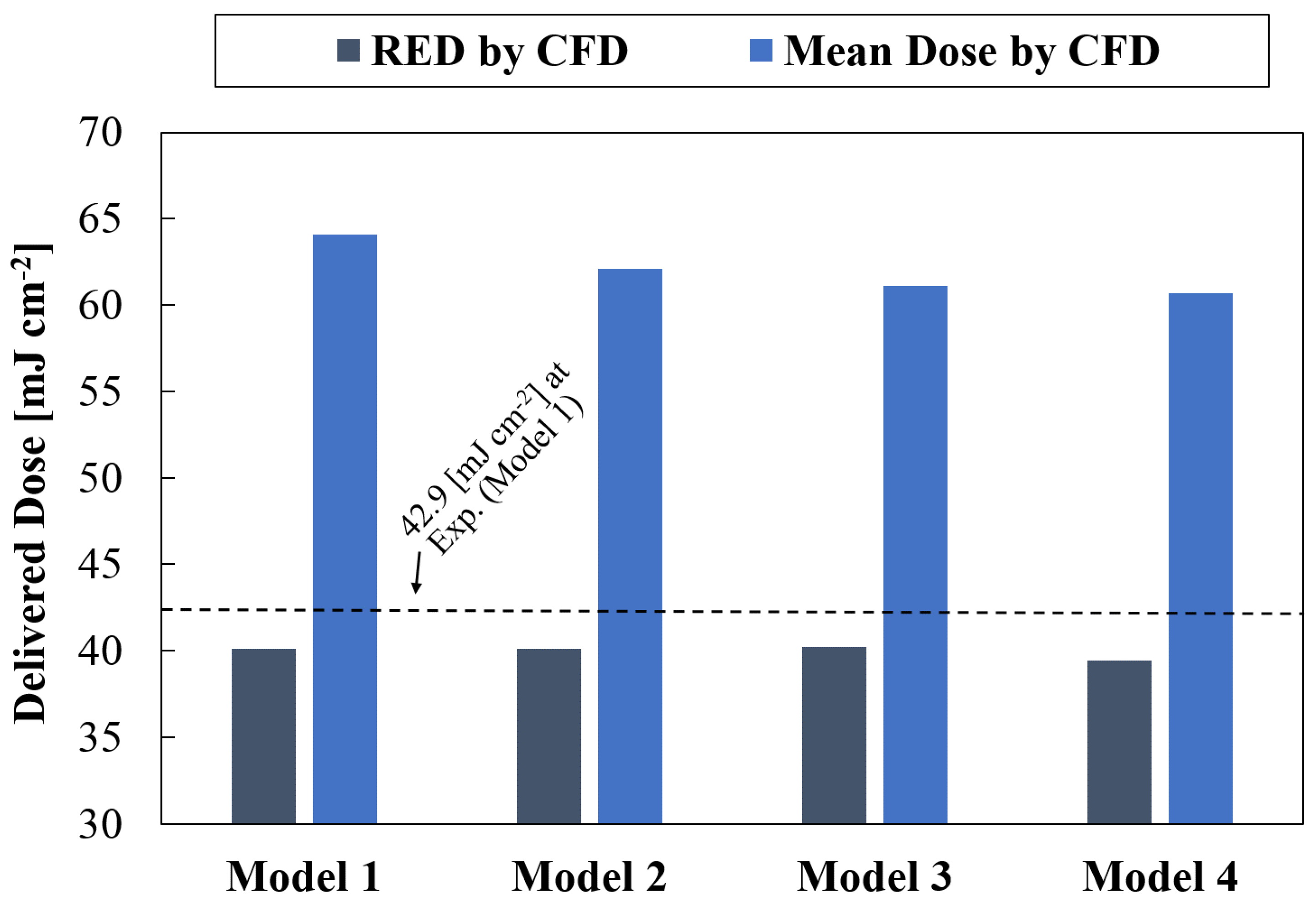
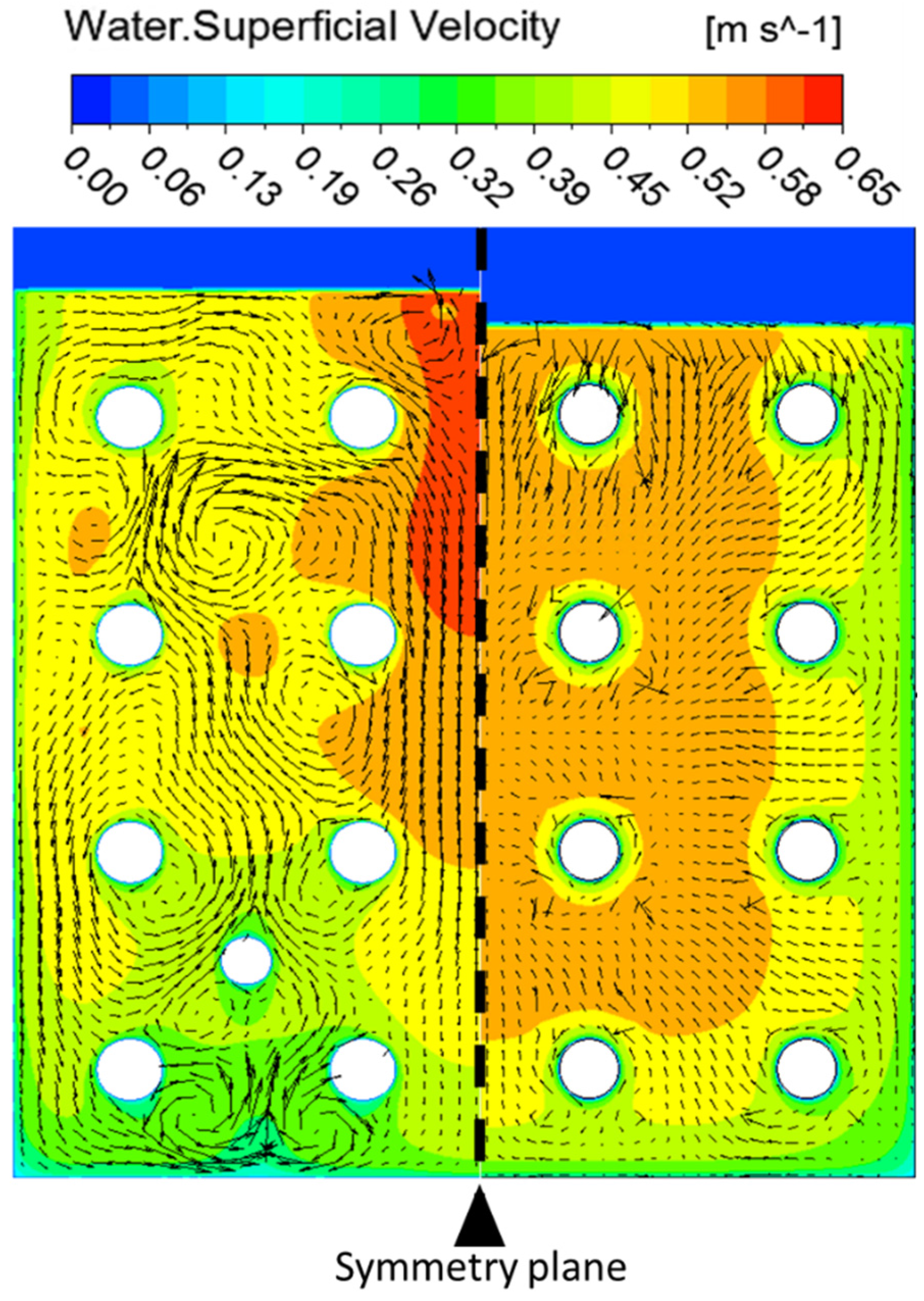
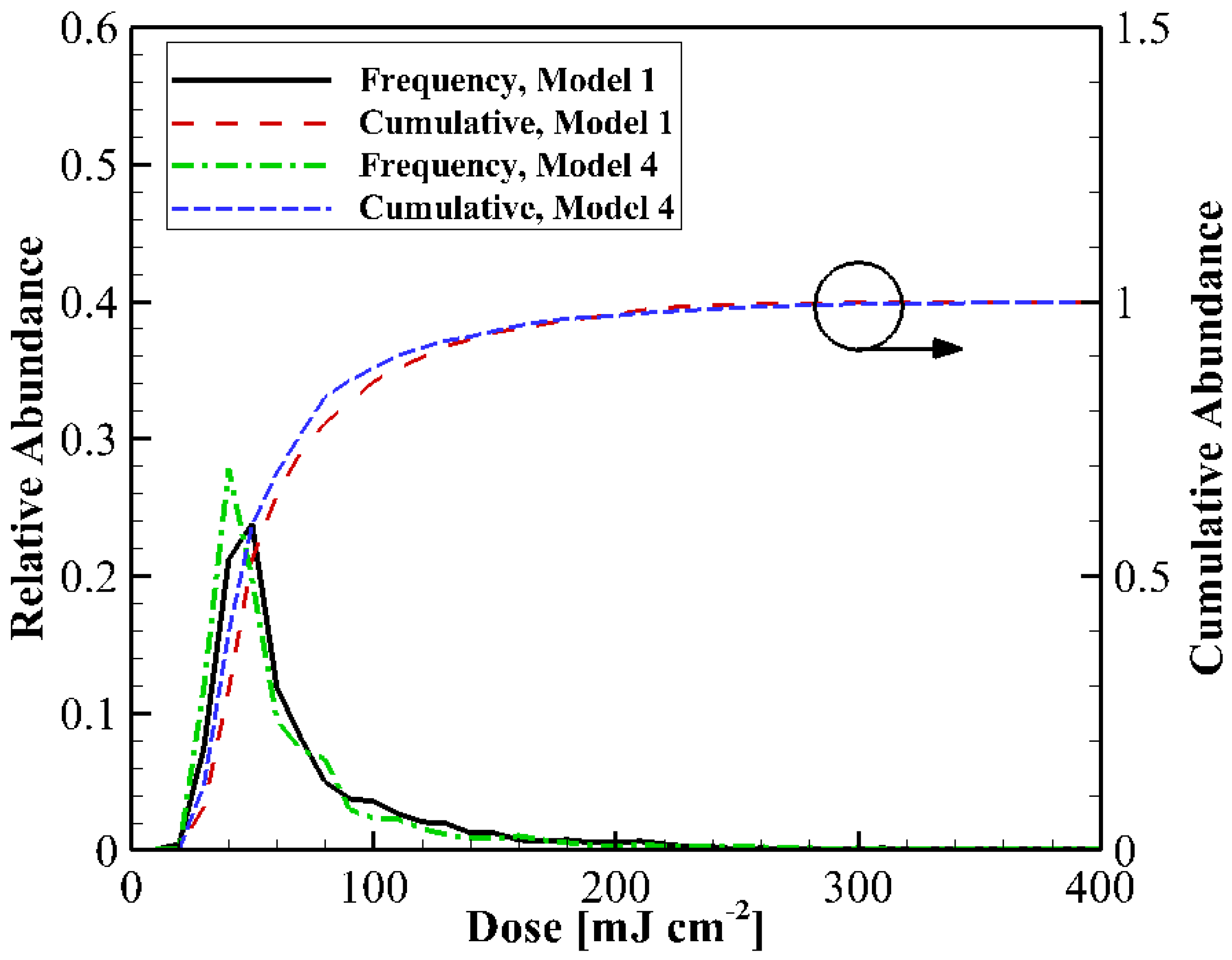

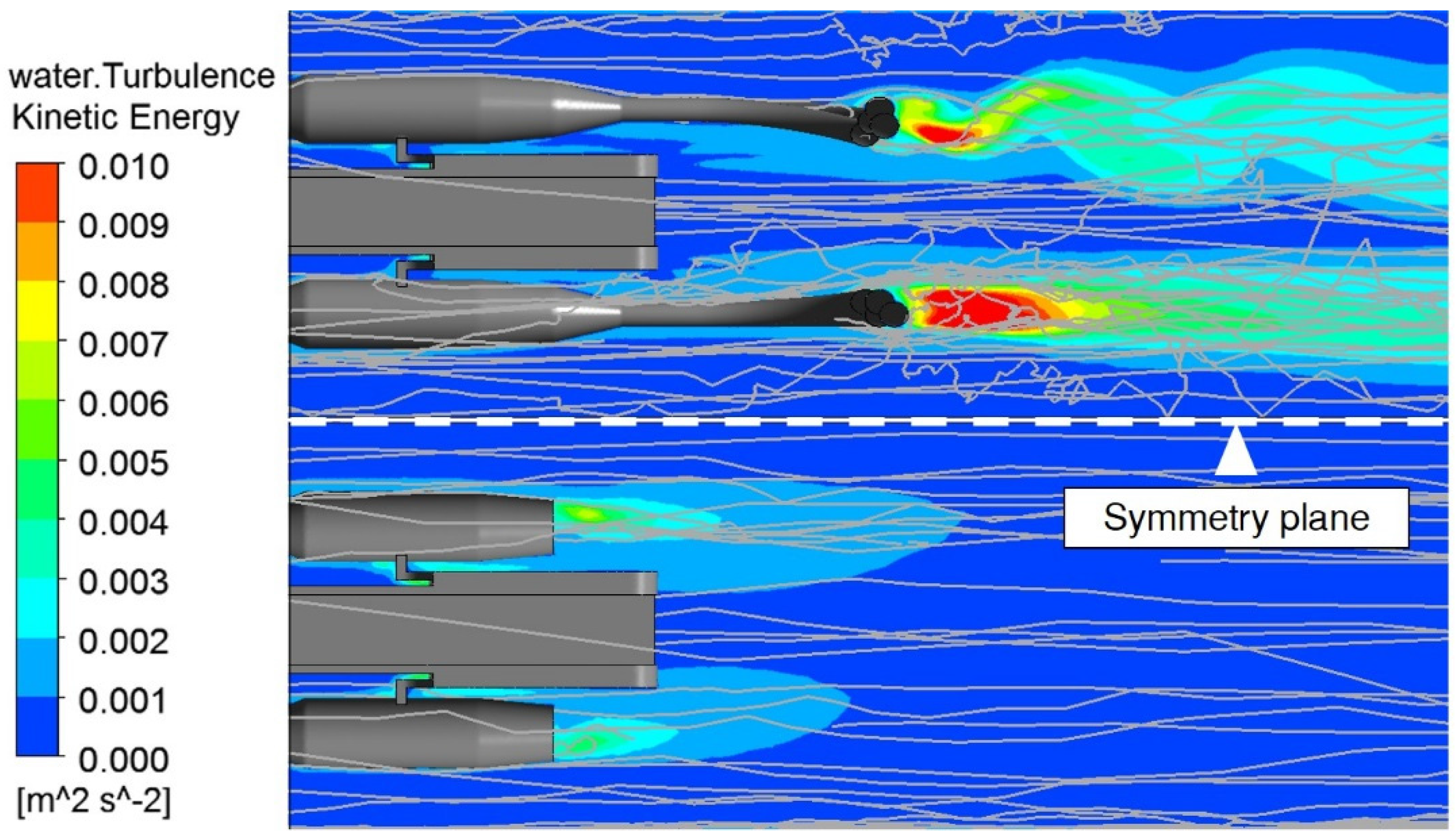
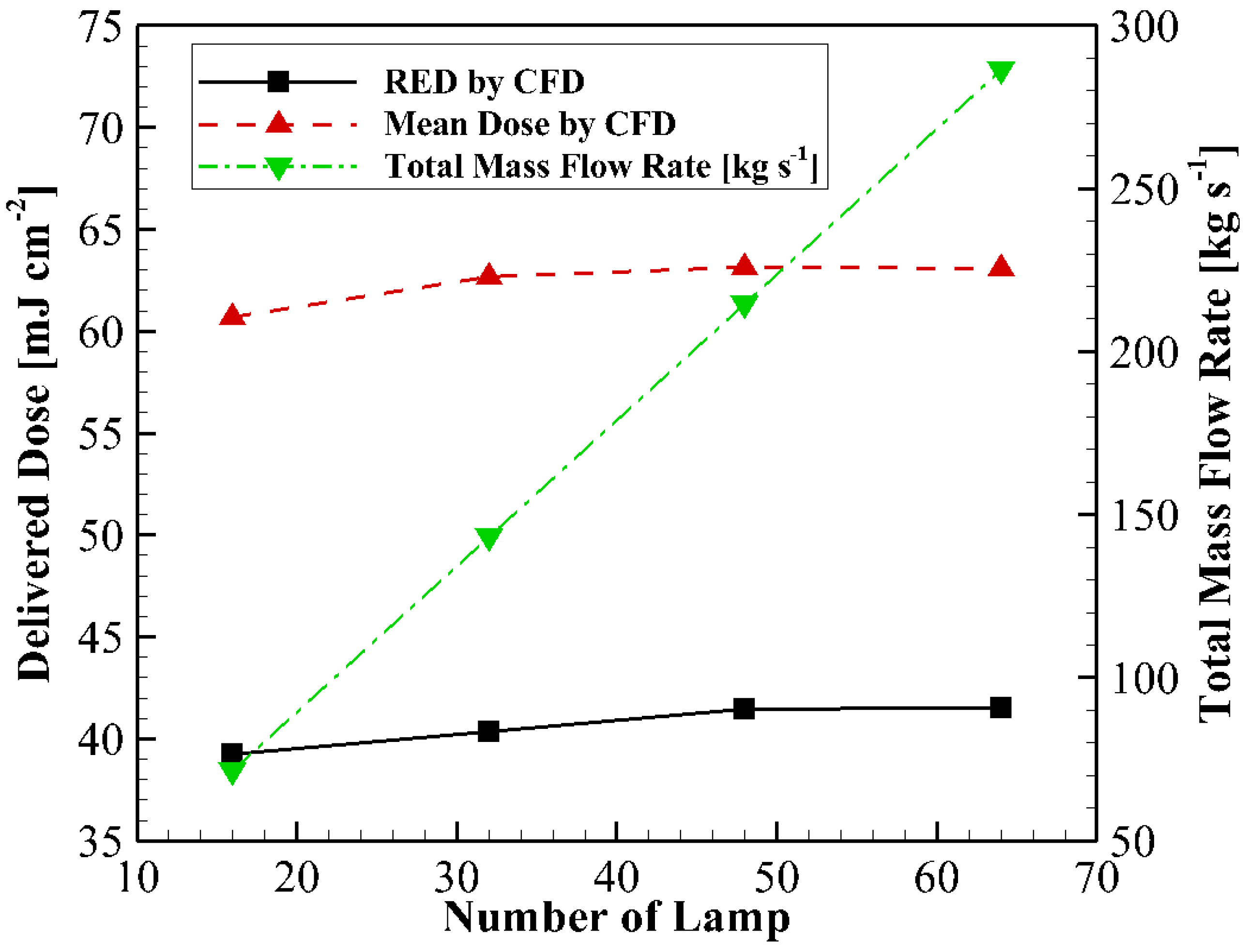
| Parameters | Value |
|---|---|
| Reactor Type | Open channel |
| Sleeve Wiping System | None |
| Lamp Specification | Low-pressure amalgam lamp, maximum power of 320 W |
| Lamp Manufacturer | Light Sources, Inc. |
| Mounting Position of Lamp | Mounted horizontally and parallel to the flow |
| Number of Modules per Bank | 2 |
| Number of Lamps per Module | 8 |
| Total Number of Lamps per Bank | 16 |
| Number of Tested Banks per Reactor | 2 |
| Total Number of Lamps Tested | 32 |
| Operating Approach | “Dose-pacing” methodology |
| Parameter | Model 1 | Model 2 | Model 3 | Model 4 |
|---|---|---|---|---|
| Elements 1 | 52.9 million | 39.9 million | 35.6 million | 6.2 million |
| Nodes | 22.3 million | 18.9 million | 14.4 million | 6.4 million |
| Category | Model 1 | Model 2 | Model 3 | Model 4 |
|---|---|---|---|---|
| Inlet | Mass flow rate 1; VFw = 1, VFa = 0 | Mass flow rate; VFw = 1, VFa = 0 | Mass flow rate; is function of water level | Mass flow rate; is function of water level |
| Outlet | Pressure: 1 atm. | Hydrostatic pressure | Hydrostatic pressure | Hydrostatic pressure |
| Upper side | Opening: VFw = 0, VFa = 1 | |||
| Wall side | Automatic near-wall treatment [21,27] | |||
| Particle Injection | Number of Injection: 5000, Density: same as water, Diameter: 1-μm | |||
| UVCalc3D | Sleeve transmittance: 0.9, Sleeve R.I. 2: 1.51, Medium R.I.: 1.372 | |||
© 2017 by the authors. Licensee MDPI, Basel, Switzerland. This article is an open access article distributed under the terms and conditions of the Creative Commons Attribution (CC BY) license (http://creativecommons.org/licenses/by/4.0/).
Share and Cite
Bak, J.-G.; Hwang, W.; Cho, J. Geometry Defeaturing Effects in CFD Model-Based Assessment of an Open-Channel-Type UV Wastewater Disinfection System. Water 2017, 9, 641. https://doi.org/10.3390/w9090641
Bak J-G, Hwang W, Cho J. Geometry Defeaturing Effects in CFD Model-Based Assessment of an Open-Channel-Type UV Wastewater Disinfection System. Water. 2017; 9(9):641. https://doi.org/10.3390/w9090641
Chicago/Turabian StyleBak, Jeong-Gyu, Woochul Hwang, and Jinsoo Cho. 2017. "Geometry Defeaturing Effects in CFD Model-Based Assessment of an Open-Channel-Type UV Wastewater Disinfection System" Water 9, no. 9: 641. https://doi.org/10.3390/w9090641





